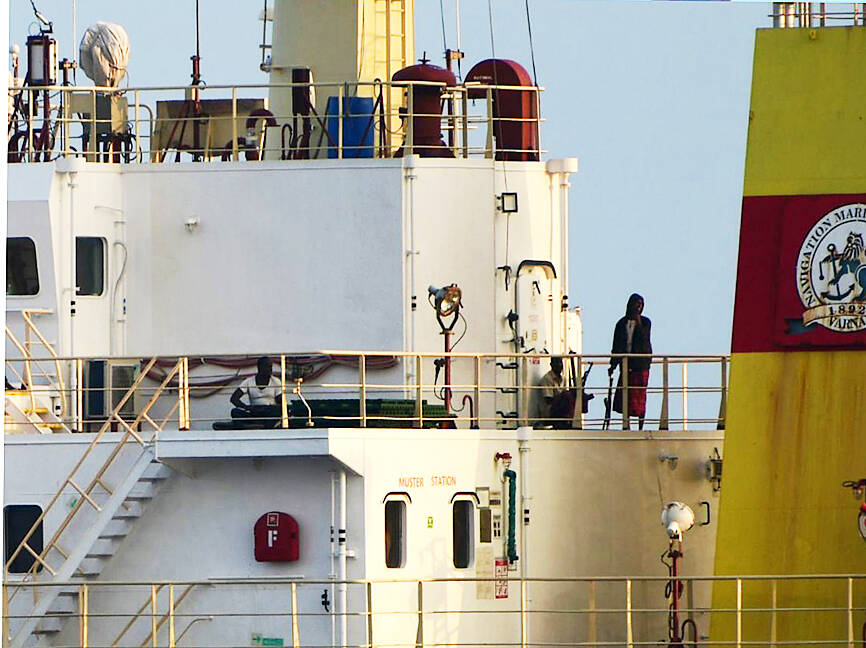The Indian Navy on Saturday recaptured a ship from Somalian “pirates” off the Indian coast, the military said, rescuing the crew and ending a three-month takeover of the Maltese-flagged bulk carrier MV Ruen.
The hijacking of the ship in December last year was the first time since 2017 that any cargo vessel had been successfully boarded by Somalian pirates.
“#IndianNavy thwarts designs of Somalian pirates to hijack ships plying through the region by intercepting ex-MV Ruen,” the navy wrote on X.

Photo: Indian Navy on X via AP
The Indian warship INS Kolkata “in the last 40 hours, through concerted actions successfully cornered and coerced all 35 Pirates to surrender & ensured safe evacuation of 17 crew members,” the navy wrote.
Indian forces first intercepted the MV Ruen on Friday, the navy wrote.
“The vessel opened fire on the warship, which is taking actions [in accordance with] international law, in self-defence & to counter piracy, with minimal force necessary to neutralise the pirates’ threat to shipping and seafarers,” the navy wrote.
None of the rescued crew members were injured in the multi-day operation, which was carried out in conjunction with several naval vessels, as well as helicopters and other aircraft, the navy said. The pirated ship was recaptured nearly 1,400 nautical miles (2,593km) from the Indian coast, the military said.
The Indian Navy has kept tabs on the MV Ruen since it was seized by Somalian pirates 380 nautical miles east of the Yemeni island of Socotra. The pirates, who at the time released one injured sailor into the care of the navy, had taken the MV Ruen and its remaining 17 crew members to Somalia’s semi-autonomous state of Puntland, where the navy said it was moored off the city of Bosaso.
The Indian military has stepped up its anti-piracy efforts in the past few months following an uptick in maritime assaults, including in the Arabian Sea and by Yemen’s Iran-backed Houthi rebels in the Red Sea.
Pirate attacks off the Somalian coast peaked in 2011 — with gunmen launching attacks as far as 3,655km from the Somalian coast in the Indian Ocean — before falling off sharply in the past few years.
However, December’s attack followed a spike in armed seaborne attacks around the Horn of Africa not seen in years.
Analysts say Somalian piracy poses nowhere near the threat it did in 2011, when navies around the world had to deploy warships to beat them back.
However, this recent upswing in pirate activity has raised further concerns about marine security and shipping at a time when crucial trade corridors off Yemen have come under siege.
Since the Houthi attacks, many cargo ships have slowed down far out at sea to await instructions on whether to proceed to the Red Sea, which experts say can make them vulnerable to attack.

Drug lord Jose Adolfo Macias Villamar, alias “Fito,” was Ecuador’s most-wanted fugitive before his arrest on Wednesday, more than a year after he escaped prison from where he commanded the country’s leading criminal gang. The former taxi driver turned crime boss became the prime target of law enforcement early last year after escaping from a prison in the southwestern port of Guayaquil. Ecuadoran President Daniel Noboa’s government released “wanted” posters with images of his face and offered US$1 million for information leading to his capture. In a country plagued by crime, members of Fito’s gang, Los Choneros, have responded with violence, using car

CYBERCRIME, TRAFFICKING: A ‘pattern of state failures’ allowed the billion-dollar industry to flourish, including failures to investigate human rights abuses, it said Human rights group Amnesty International yesterday accused Cambodia’s government of “deliberately ignoring” abuses by cybercrime gangs that have trafficked people from across the world, including children, into slavery at brutal scam compounds. The London-based group said in a report that it had identified 53 scam centers and dozens more suspected sites across the country, including in the Southeast Asian nation’s capital, Phnom Penh. The prison-like compounds were ringed by high fences with razor wire, guarded by armed men and staffed by trafficking victims forced to defraud people across the globe, with those inside subjected to punishments including shocks from electric batons, confinement

The team behind the long-awaited Vera Rubin Observatory in Chile yesterday published their first images, revealing breathtaking views of star-forming regions as well as distant galaxies. More than two decades in the making, the giant US-funded telescope sits perched at the summit of Cerro Pachon in central Chile, where dark skies and dry air provide ideal conditions for observing the cosmos. One of the debut images is a composite of 678 exposures taken over just seven hours, capturing the Trifid Nebula and the Lagoon Nebula — both several thousand light-years from Earth — glowing in vivid pinks against orange-red backdrops. The new image

Canada and the EU on Monday signed a defense and security pact as the transatlantic partners seek to better confront Russia, with worries over Washington’s reliability under US President Donald Trump. The deal was announced after a summit in Brussels between Canadian Prime Minister Mark Carney and European Commission President Ursula von der Leyen and European Council President Antonio Costa. “While NATO remains the cornerstone of our collective defense, this partnership will allow us to strengthen our preparedness ... to invest more and to invest smarter,” Costa told a news conference. “It opens new opportunities for companies on both sides of the